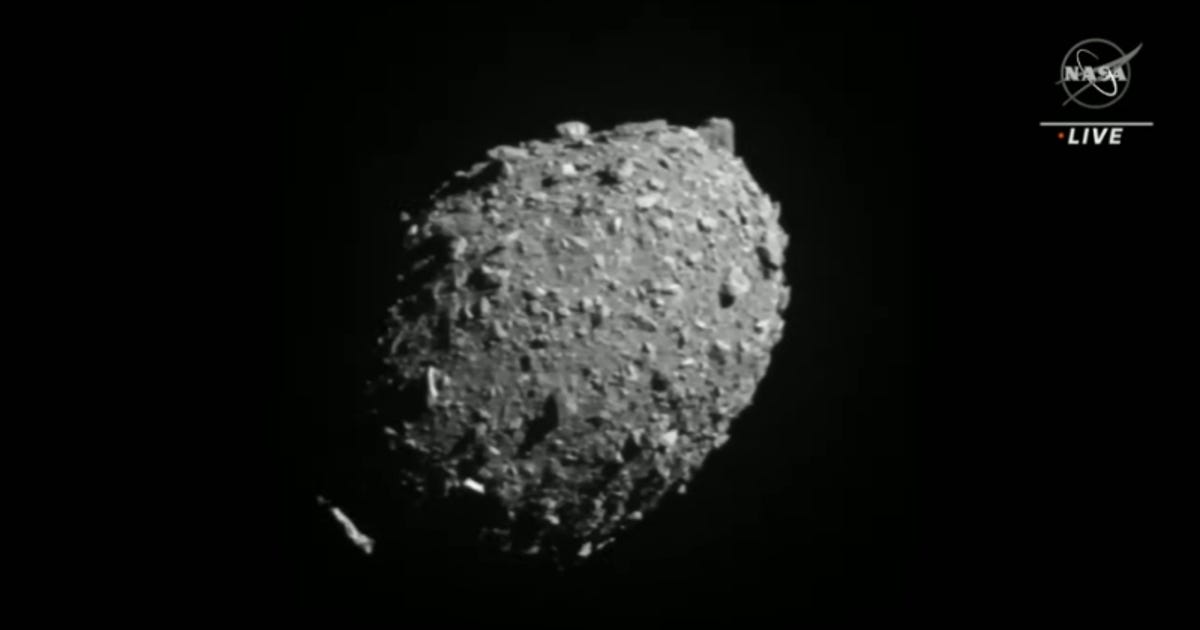
NASA’s trailblazing planetary defense probe, DART, spent the last 306 days calmly cruising through space toward its own gravesite: a Colosseum-size asteroid known as Dimorphos. At around 3 p.m. on Monday, the pepita-shaped rock emerged from the void; just a few pixels of white light on the probe’s camera.
Second by second, the $325 million, 1,200-pound spacecraft inched closer to its final destination. The asteroid grew larger, becoming a pinprick of light, then a rugged sphere. Eventually, it enveloped the screen. At 4:14 p.m. DART’s cameras went red. In mission control, a team member’s voice crackled over the intercom, indicating a loss of signal.
The probe had slammed into the asteroid at around 14,000 miles per hour. Now DART is at rest in its own shallow grave on the surface of Dimorphos. That’s exactly what NASA had hoped for. Cheers and congratulations rang out through the control room at at Johns Hopkins University Applied Physics Laboratory in Maryland.
“We’ve worked on this mission for at least seven years now,” said Elena Adams, the DART system engineer at JHUAPL, continuing “to see it so beautifully concluded today was just an incredible feeling — and also, incredibly tiring.”
Unlike the rest of NASA’s deep space fleet of robots, DART was doomed by design. It’s the first test of a planetary defense technology that could one day help protect the Earth from a rogue asteroid or comet by deliberately striking it and sending it off course. DART launched in November 2021 on a carefully planned collision course to an asteroid pair, known as Didymos and Dimorphos. Its trajectory was set and monitored by artificial intelligence without the ability to course correct from the team at Johns Hopkins, which designed, developed and managed the craft.
The duo of asteroid is perfect for such a test because they pose no threat to Earth and lie in just the right spot to observe over the coming months.
Dimorphos, the smaller of the two, whips around Didymos once every 11.9 hours in a near circular orbit. You can think of it like a moon of Didymos (indeed, it’s dubbed a “moonlet” by planetary scientists). By deliberately crashing into Dimorphos, NASA hopes it will, ever so slightly, alter the moonlet’s orbit.
“This was a really hard technology demonstration to hit an asteroid we’ve never seen before,” said Nancy Chabot, DART coordination lead. “But I know other scientists on the team, like me, are already pointing at those images being like ‘Did you see that boulder? Did you see that smooth area? What does that mean?'”
Crashing into the asteroid is predicted to change its speed by a tiny fraction of a percent — it doesn’t sound like much, but in orbital dynamics those tiny fractions can make a big difference to the time it takes for Dimorphos to make one full orbit of Didymos.
According to X, the team thinks they were about 17 meters away from their
Didymos, the larger of the asteroid pair, about 40 minutes before impact. If you expand the image you might just be able to see Dimorphos at the 2pm position.
NASA
If NASA scientists can show the orbit is altered, it will demonstrate we may be able to shift the orbits of Earth-threatening asteroids in the future and prevent them from barreling into the planet.
More than two dozen Earth-based telescopes will now observe the asteroid pair over the coming weeks and months to try to determine exactly how much the impact altered the orbit of Dimorphos. Scientists can’t directly see the smaller asteroid from our vantage point, 7 million miles away, but they can see how its orbit affects light from Didymos. This should clue them into whether the impact gambit worked.
Space-based telescopes will also observe the impact. Astronomy’s current darling, the James Webb Space Telescope, will be observing the impact and hoping to image the evolution of the ejecta — how things change after the collision.
Scientists will also be able to investigate the crash site with images beamed back by a cubesat, built by the Italian space agency, that rode shotgun with DART. The cubesat, known as LICIAcube, was released from DART just over two weeks ago and followed the spacecraft in as it made its final death dive. It will already be taking photographs of the scar left on the face of Dimorphos, and it won’t be long before we get to see those images.
Looking further into the future, the asteroid pair will have another visitor in 2024. The European Space Agency’s Hera satellite is scheduled to fly out toward the asteroid pair and scope out the damage.
“We’re embarking on a new era of humankind. An era in which, we, potentially have the capability to protect ourselves from a dangerous, hazardous asteroid impact,” said Lori Glaze, NASA’s Planetary Science Division director.
NASA Successfully Crashes Its DART Probe Into Asteroid Dimorphos – CNET
Source: Media Star Philippines


0 Comments